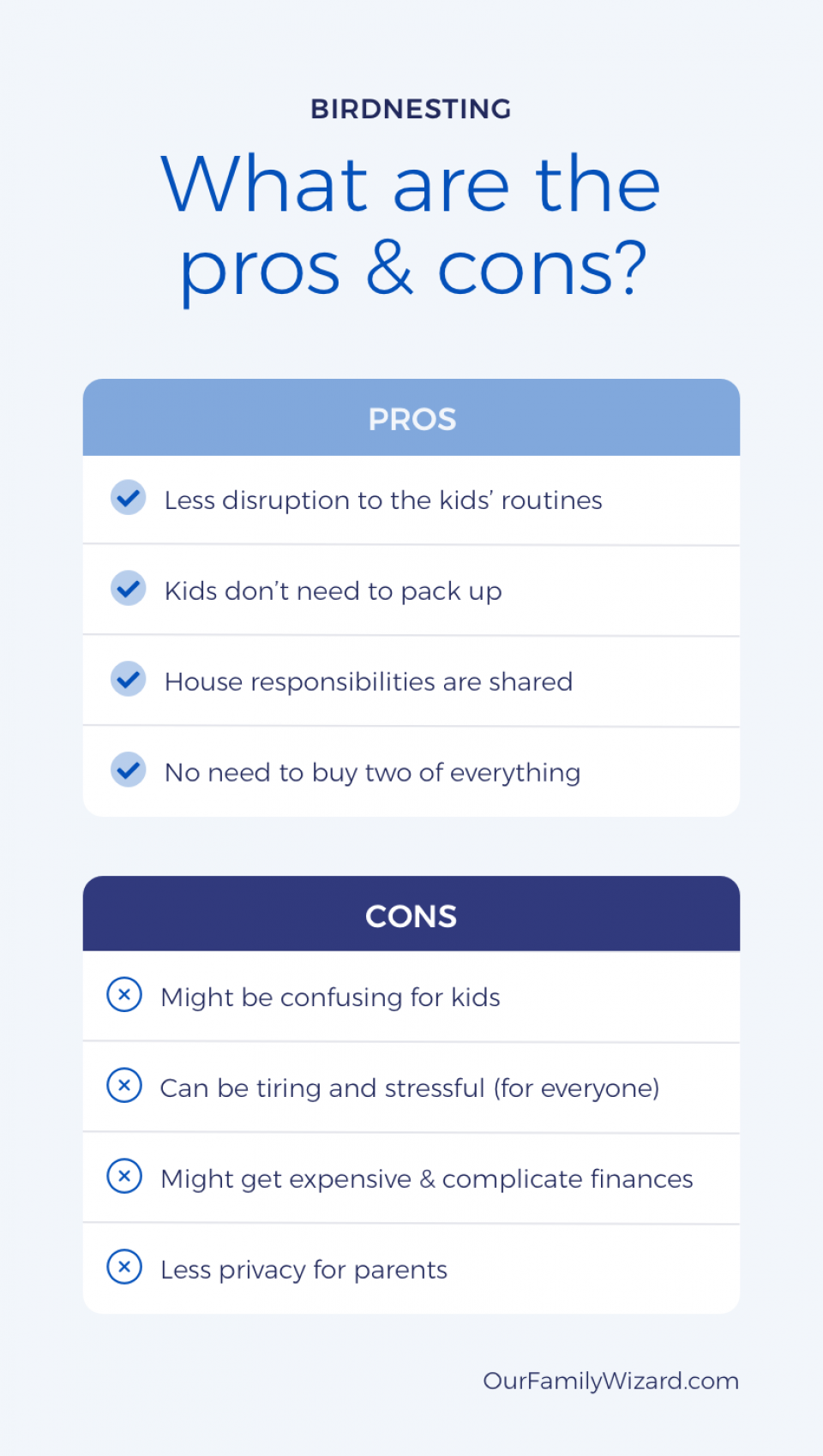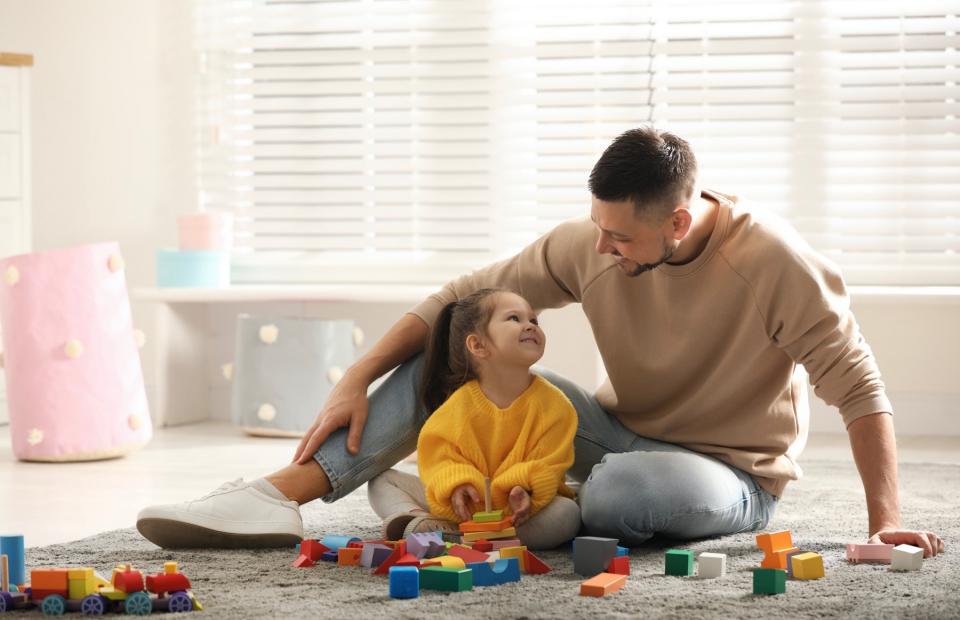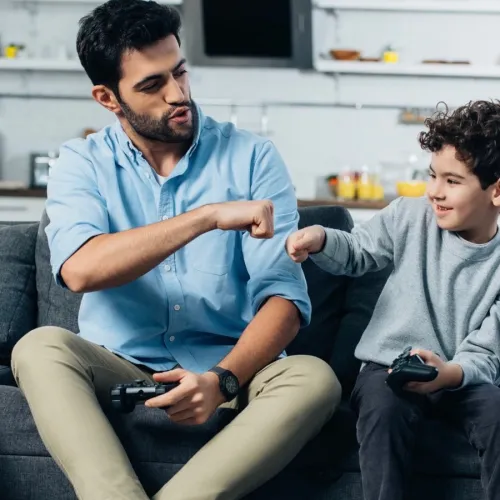Birdnesting During a Divorce or Separation – Share the Family Home, at Different Times
When birdnesting after divorce or separation, the children stay in the family home—a safe and cozy nest—and the parents take turns living with them.
When one parent is staying with the kids, the other parent stays at another place, like a rented apartment or a family member’s house. Then they swap, and the other parent stays with the children while the parent who was with the kids before stays somewhere else.
Inside this article
- Why is it called birdnesting?
- Is birdnesting divorce a good idea?
- How will birdnesting affect your children?
- Pros: Why should you choose nesting separation?
- Cons: What are the downsides of birdnesting?
- What should you consider before birdnesting?
- How can co-parents nest successfully?
- Sample birdnesting schedules
- Simplify, streamline, and make family nesting as easy as possible
- The bottom line

Why is it called birdnesting?
Bit of a funny name, but a cute backstory. In nature, little baby birds stay in the nest, and mom and dad take turns leaving to find food. With human birdnesting, the kids keep living at home, while mom and dad swap out.
You may also see birdnesting referred to as family nesting, a nesting plan, or nesting separation.
“A short-term nesting plan is incredibly beneficial to children at the initial stages of a divorce or separation,” explains Elle Barr, an experienced family law attorney and a court-appointed guardian ad litem, or child welfare expert and attorney for children, for nearly 20 years.
Is birdnesting divorce a good idea?
Family nesting can give the kids a sense of stability. “Children feel a lot of confusion and sadness when their parents split up,” explains Barr. “Nesting minimizes these overwhelming emotions and feelings. It provides children with a sense of safety, consistency, and stability while they adjust and adapt during this very difficult time.”
With birdnesting divorce or nesting separation, the kids’ day-to-day lives stay largely unchanged, giving them more emotional space to adjust to their parents’ separation. But it’s best as a short-term solution. If it goes on too long, nesting can confuse kids, leading them to believe their parents might get back together.
How will birdnesting affect your children?
Divorce affects children deeply, and it can even rise to the level of an adverse childhood experience or ACE. (Read more about the signs and symptoms of stress in children.)
Family nesting limits the adversity that children have to experience during their parents’ divorce. This helps keep them happy, healthy, and well-adjusted—now and into the future.

Birdnesting plans: The pros and cons
Still, like any divorce or separation, the situation can be complicated—and a nonstandard arrangement comes with different pros and cons.
Pros: Why should you choose nesting separation?
“Birdnesting prioritizes the kids,” according to Barr. “It’s not easy, but it’s all about putting their needs first.”
It’s simpler. Nesting co-parenting is less of a serious upheaval. The end of your marriage or relationship is enough of a transition for the kids, and this way, you don’t have to uproot their living situation, too.
“The children can come to terms with the divorce or separation with significantly less anxiety, uncertainties, and disruptions in their lives and routines,” explains Barr.
No switching houses. The kids always sleep in the same bed, wake up in the same place, and have easy access to everything they own. It keeps them feeling steady in a time of major change.
Less packing. No need to gather up the kids’ stuff and worry about forgetting homework, a leotard, or a lovey. And no last-minute problem-solving if your co-parent forgot something. Everything stays where it’s easily accessible. You’ll have to pack your stuff, but it’s a lot easier to keep track of.
Share the burden equally. Keeping a single home base makes it easy to split responsibilities 50-50. You have to coordinate to keep the household running smoothly (otherwise you’ll drive each other nuts—in which case, birdnesting might not be the ideal scenario for you).
No need to buy doubles. If your kids schlep between separate homes, you can pack up some stuff, but you’ll definitely need two beds. You can bring some favorites along, but you won’t want to pack up every single toy, so you’ll need two sets. Plus extra clothes for each kid.
With birdnesting, you only need one bed, one toy collection, one wardrobe per kid. Simple.
Read more: 6 Tips for Supporting Kids Through Change
Cons: What are the downsides of birdnesting?
It can be confusing. Nesting is simpler for the kids—but maybe too simple, and some experts think family nesting could be psychologically unhealthy. If it doesn’t feel like much has changed, it can be harder for kids to process, accept, and adjust to their parents’ divorce or separation.
It can be tiring and stressful. Sharing a home instead of making a clean break can complicate things emotionally—for you as well as for your kids. It’s important to focus on your self-care during a divorce or separation.
It’s usually expensive. Although you don’t need to buy extra stuff, you may need to buy an extra dwelling. There are two options:
- You can share a second house or apartment with your co-parent, taking turns. This place can be smaller since you don’t need room for the kids.
- You can get your own space—a place where you can feel independent of your former partner. If you both rent separate apartments, then between the two of you, you have to maintain three separate living situations. That’s out of budget for a lot of families.
It complicates the finances. How will you split utilities and other bills? What happens to child support? Some families split expenses 50:50, while others choose percentages that reflect the co-parents’ different incomes.
And what happens if the fridge breaks—who pays? (And who supervises the repair specialist?)
Or if the roof needs repair, should both parents share the bill, even though only one of them is going to keep the house post-nesting?
It’s less private. Your belongings and lifestyle are easily observable by your co-parent, especially if you share both homes.

What should you consider before birdnesting?
Divorce is complicated for the whole family—even if you’re nesting. You may want to work with a therapist to develop a nesting plan, suggests Ann Gold Buscho, author of The Parent’s Guide to Birdnesting, in Psychology Today.
Before jumping into this kind of arrangement, consider the following issues:
Your relationship with your co-parent. Nesting really only works if you two can work together. “First, and most important,” writes journalist Katie Hafner in HuffPost, “there must be a supernatural degree of civility and cooperation between the two ex-spouses.”
Plus, you’ll need to tackle household problems together. At some point, there’s going to be a broken toilet or a garage door that won’t open. Who’s going to pay for it? Who’s going to supervise the repair specialist?
Your kids’ ages. Younger kids are more likely to be confused about whether their parents have really split. And they might adjust to two houses more easily than older kids.
But older kids might appreciate the lesser disruption offered by family nesting. They might have an easier time understanding the divorce or separation, so nesting is less likely to be confusing.
Your living arrangements. Do you plan to share a second home? Can you agree on an apartment? Do you plan to bring new partners into that home? These are all decisions to make before you start nesting.
Your finances. Nesting separation can either save you money (if you don’t buy two sets of everything) or cost more than a traditional divorce (if you maintain three houses). You’ll have to figure out a nesting plan that works for your budget—and decide whether that works for you practically and emotionally.
The housing market. If you plan to sell your house eventually, you’ll want to time it right. If the market is hot, you might want to sell your home sooner. If you miss a seller’s market, you might regret the timing. (On the other hand, if the market is slow, it might serve you well to wait!)
How can co-parents nest successfully?
Be clear with the kids. Explain in no uncertain terms that you and your former spouse or partner have ended your romantic relationship and are now only co-parents to each other. You’re not getting back together.
Keep it short-term, no more than 3-6 months. At most, stick it out until the end of the school year—or if it’s almost the end, then till the end of the summer. If you nest for longer, it could give your children false hope that you and your co-parent will reconcile.
“Some co-parents choose to nest longer,” Barr says. “But it’s really best as a transition plan.”
Plus, if either of you gets a new partner, it can be tricky bringing them home to the home you still share. It might feel frustrating to the kids to have a new partner in the same home they share with both parents.
Follow the 3 C’s: communicate, cooperate, compromise.
Communicate. If there’s conflict between you, then there’s conflict in the family home. Healthy communication is one way to protect your kids during divorce.
Cooperate. You both have to work together to keep everything stable and consistent for your kids. If you’re dealing with an uncooperative co-parent, nesting is probably not the right choice for your family.
Compromise. Parenting is all about problem-solving, and with co-parenting, you have to solve the problem together and reach a child-centered conclusion.
“When I’m appointed to cases where the parents choose birdnesting,” Barr says, “They’re usually low conflict. The parents are just figuring things out, and they’re prioritizing their kids.”

Sample birdnesting parenting schedules
According to Barr, 50-50 parenting time schedules are ideal for nesting. Nesting is all about what’s best for the kids, and kids often thrive when they have two equally involved parents. Plus, this makes sure no one feels like they’re running the house single-handedly.
Whichever nesting plan you choose, it’s important to help your children manage their emotions during parenting time transitions. Here are three popular options:
- Switch every other week. One of the simplest schedules, the every-other-week system gives you a nice long time with the kids. It can be more relaxing and less hectic than shorter stays. But if your kids really miss you, shorter stays might work better.
- 2-2-3. You stay with the kids on Monday and Tuesday, then your co-parent stays with them for Wednesday and Thursday. Then you stay with them for three days over the weekend. Next, you swap.
The kids get to see you both frequently, which makes the transitions easier. Plus, you and your co-parent get turns staying with the kids for the weekend. - 2-2-5-5. A happy medium between the two other options. You get a nice long 5-day stay with the kids, and they get a nice long stretch without a transition.
An added benefit: With this schedule, the kids are always with the same parent Mondays and Tuesdays, and the other parent Wednesdays and Thursdays. Only Fridays through Sundays alternate.
This makes weekly commitments easier. If you want your child to take gymnastics lessons and your co-parent is indifferent, then you can schedule the lessons for Mondays, and you’ll always be the one to take your child to the gym.
Simplify, streamline, and make family nesting as easy as possible
Nesting can be complicated, but using a co-parenting app can help. OurFamilyWizard makes it easy to set up a parenting time schedule, and you and your co-parent can view the same shared calendar.
The messaging feature documents all your virtual communications—which makes it easy to discuss things where the kids can’t overhear. Then you can keep all your in-person interactions short and sweet.
Best of all, OurFamilyWizard helps you minimize conflict so your family can thrive during this transition period (and after).
How can a co-parenting app help you manage family nesting?
Learn more about OurFamilyWizard
The bottom line
Family nesting can be expensive, confusing, and emotionally difficult. But if the situation is a good fit, it can offer stability and comfort to the kids while you and your co-parent go through a divorce or separation.
It’s a complicated decision, but at the end of the day, it’s all about choosing what’s best for your kids and your family.
Read Next: Co-Parenting Guide: Tips & Fundamentals for Healthy Communication After Divorce



